Pleistocene - Study guides, Class notes & Summaries
Looking for the best study guides, study notes and summaries about Pleistocene? On this page you'll find 156 study documents about Pleistocene.
All 156 results
Sort by
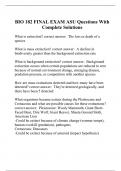 Popular
Popular
-
BIO 182 FINAL EXAM ASU Questions With Complete Solutions
- Exam (elaborations) • 14 pages • 2023
-
Available in package deal
-
- $12.99
- 2x sold
- + learn more
What is extinction? correct answer: The loss or death of a species What is mass extinction? correct answer: A decline in biodiversity greater than the background extinction rate What is background extinction? correct answer: Background extinction occurs when certain populations are reduced to zero because of normal environment change, emerging disease, predation pressure, or competition with another species How are mass extinctions detected and how many have been detected? correct an...
 Popular
Popular
-
FW 104 CSU EXAM 2 Questions With 100% Correct!!
- Exam (elaborations) • 9 pages • 2024 Popular
- Available in package deal
-
- $7.99
- 1x sold
- + learn more
Pleistocene Overkill Hypothesis - States that humans were primarily responsible for the demise of the megafauna at the close of the Pleistocene, approximately 10,000 years ago, from overhunting as human populations expanded at that time. Market Hunting Era (Era of Exploitation) - : Myth of superabundance; dark time for wildlife, new Americans claimed the right and duty to tame the land, loss of Passenger pigeons and Carolina parakeet. Era of Game Management () (conservation era) - Protecti...
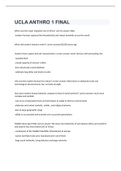
-
UCLA ANTHRO 1 FINAL exam 2022/2023 with 100% correct answers
- Exam (elaborations) • 9 pages • 2022
-
Available in package deal
-
- $17.49
- 5x sold
- + learn more
When was the major migration out of Africa? -60ka -modern humans replaced the Neanderthals and robust hominids across the world When did modern humans evolve? 200,000 years ago modern Homo sapien derived characteristics: -small, flat face with portruding chin -rounded skull -cranial capacity of at least 1,350cc -less robust post-cranial skeleton -relatively long limbs and shorter trunks why was the modern human less robust? -relied more on elaborate tools and techno...
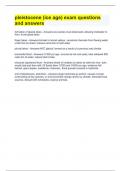
-
pleistocene (ice age) exam questions and answers
- Exam (elaborations) • 1 pages • 2024
-
Available in package deal
-
- $7.99
- + learn more
formation of glacial lakes - Answers-ice pushes crust downward, allowing meltwater to form. ie the great lakes finger lakes - Answers-formed in tunnel valleys - erosional channels from flowing water under the ice sheet. massive amounts of melt water pluvial lakes - Answers-NOT glacial. formed as a result of a previous wet climate bonneville flood - Answers-17400 yrs ago. occured at red rock pass, lake released 850 cubic km of water. natural dam broke. missoula (spokane) flood - Answe...
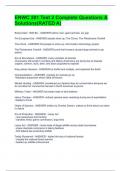
-
ENWC 201 Test 2 Complete Questions & Solutions(RATED A)
- Exam (elaborations) • 17 pages • 2024
-
Available in package deal
-
- $13.99
- + learn more
Before Man: 1500 BC - ANSWER before man, giant animals, ice age Pre European Era - ANSWER people show up, The Clovis, The Pleistocene Overkill The Clovis - ANSWER first people to show up, had modern technology (spear) The Pleistocene Overkill - ANSWER proof that humans caused large animals to go extinct Era of Abundance - ANSWER -many varieties of animals -Europeans still small in numbers and Native Americans are dying due to disease -pigeon, salmon, duck, deer, and bison populatio...
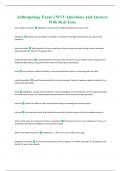
-
Anthropology Exam 3 WVU Questions And Answers With Real Tests
- Exam (elaborations) • 11 pages • 2024
-
- $11.99
- + learn more
Anthropology Exam 3 WVU Questions And Answers With Real Tests what are the three most important hominin evolutions? the Pliocene (5 to 2 m.y.a.), Pleistocene (2 m.y.a. to 10,000 B.P.) and Recent (10,000 B.P. to the present) epochs What are the six species in chronological order? 1. A. anamnesis (4.2 to 3.9 m.y.a.). 2. A. afarensis (3.8? to 3.0 m.y.a.). 3. A. africanus (3.0? to 2.0? m.y.a.). 4. A. garhi (2.5 m.y.a.) 5. A. robustus (2.0? to 1.0? m.y.a.). 6. A. boisei (2.6? to 1.0 m.y.a.). ...
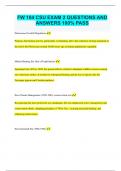
-
FW 104 CSU EXAM 2 QUESTIONS AND ANSWERS 100% PASS
- Exam (elaborations) • 15 pages • 2024
-
Available in package deal
-
- $9.99
- + learn more
FW 104 CSU EXAM 2 QUESTIONS AND ANSWERS 100% PASS Pleistocene Overkill Hypothesis Proposes that human activity, particularly overhunting, led to the extinction of large mammals at the end of the Pleistocene around 10,000 years ago as human populations expanded. Market Hunting Era (Era of Exploitation) Spanning from 1850 to 1899, this period reflects a belief in abundant wildlife resources among new American settlers. It resulted in widespread hunting and the loss of species like...
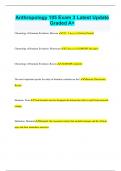
-
Anthropology 105 Exam 3 Latest Update Graded A+
- Exam (elaborations) • 25 pages • 2024
- Available in package deal
-
- $9.99
- + learn more
Anthropology 105 Exam 3 Latest Update Graded A+ Chronology of Hominin Evolution: Miocene (23 - 5 m.y.a.) (Tertiary Period) Chronology of Hominin Evolution: Pleistocene (2 m.y.a. to 10,000 BP) (Ice ages) Chronology of Hominin Evolution: Recent (10,000 BP to present The most important epochs for study of hominin evolution are the? Miocene, Pleistocene, Recent Hominin: Term Term hominin used to designate the human line after its split from ancestral chimps Definition: Hominid...

-
Anthropology Exam 3 WVU Questions And Answers With Real Tests
- Exam (elaborations) • 9 pages • 2024
-
- $11.49
- + learn more
Anthropology Exam 3 WVU Questions And Answers With Real Tests what are the three most important hominin evolutions? the Pliocene (5 to 2 m.y.a.), Pleistocene (2 m.y.a. to 10,000 B.P.) and Recent (10,000 B.P. to the present) epochs What are the six species in chronological order? 1. A. anamnesis (4.2 to 3.9 m.y.a.). 2. A. afarensis (3.8? to 3.0 m.y.a.). 3. A. africanus (3.0? to 2.0? m.y.a.). 4. A. garhi (2.5 m.y.a.) 5. A. robustus (2.0? to 1.0? m.y.a.). 6. A. boisei (2.6? to 1.0 m.y.a.). ...

-
ASB 222 TOP Exam Questions and CORRECT Answers
- Exam (elaborations) • 40 pages • 2024
-
- $8.99
- + learn more
Earth ageAbout 4.6 billion years Universe10 billion years PrecambrianFirst major era of geological time, extending from the origins of earth to about 600 m.y.a PaleozoicThe appearance of the first vertebrate species: fish and amphibians Mesozoic eraAround 245 mya. The age of dinosaurs CenozoicPeriod of extinction, our current era. Divided into 7 epochs: Epochs (discussed on page 4)There are 7 epochs: Holocene, pleistocene, pliocene, miocene, oligocene, eocene, and paleocene (in order f...

Did you know that on average a seller on Stuvia earns $82 per month selling study resources? Hmm, hint, hint. Discover all about earning on Stuvia


